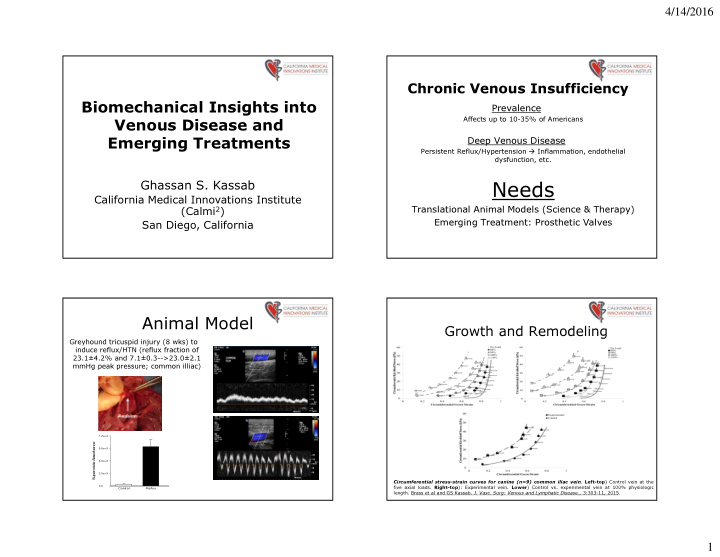



4/14/2016 Chronic Venous Insufficiency Biomechanical Insights into Prevalence Affects up to 10-35% of Americans Venous Disease and Deep Venous Disease Emerging Treatments Persistent Reflux/Hypertension � Inflammation, endothelial dysfunction, etc. Ghassan S. Kassab Needs California Medical Innovations Institute Translational Animal Models (Science & Therapy) (Calmi 2 ) Emerging Treatment: Prosthetic Valves San Diego, California Animal Model Growth and Remodeling Greyhound tricuspid injury (8 wks) to induce reflux/HTN (reflux fraction of 23.1±4.2% and 7.1±0.3-->23.0±2.1 mmHg peak pressure; common illiac) 1.2e+4 Superoxide Absorbance 9.0e+3 6.0e+3 3.0e+3 Circumferential stress-strain curves for canine (n=9) common iliac vein . Left-top ) Control vein at the 0.0 Control Reflux five axial loads. Right-top ): Experimental vein. Lower ) Control vs. experimental vein at 100% physiologic length. Brass et al and GS Kassab. J. Vasc. Surg: Venous and Lymphatic Disease. , 3:303-11, 2015. 1
4/14/2016 Remodeling of Microstructure Remodeling of Collagen and Elastin Collagen and elastin in control and experimental common iliac venous tissue . Left ) Percent of collagen and elastin areas within the venous wall of control and experimental common iliac veins using Histological and merged SHG/TPEG images of the common iliac venous wall for control and MPM. Right ) Collagen-to-elastin ratio. Figures show grouped average for n = 6 dogs. experimental veins . Histological section of an experimental ( A ) and control ( B ) canine common iliac vein. C: Merged SHG/TPEG image of an experimental ( C ) and control ( D ) canine common iliac vein. Emerging Treatment? Uniform Stress Hypothesis? Prosthetic Venous Valves Synthetic Urethane, Pellethane, Polymers Biological Autologous, allografts, xenograft, manufactured Failure modes Thrombosis, Leaflet Remodeling: Design, No load state wall thickness and Circumferential stress at different states . Left ) Total wall material selection thickness and intimal-medial thickness at the no load state in control and experimental canine common iliac veins. Right ) Circumferential stress for control pressure (Control; 7 mmHg), pressure-overload (Control; 20 mmHg) immediately after injury and chronic hypertensive pressure (8 weeks; 20 mmHg) in canine common iliac vein. * p < 0.05 vs. Control; 20 mmHg 2
4/14/2016 In Vivo: Valve Performance In Vivo: Valve Performance * 1.2e+4 60 25 Mean Venous Outflow Velocity (cm/s) Reflux Fraction Venous Outflow Superoxide Absorbance Venous Reflux Fraction (%) 50 20 9.0e+3 40 15 6.0e+3 30 * 10 20 3.0e+3 5 10 0 0 0.0 Reflux Valve Control Reflux Valve Safety and Competency of Prosthestic Valve at 4 weeks Post Implant . Left ) DUS image of valve Efficacy of Prosthestic Valve at 4 weeks Post Implant . Left ) Reflux fraction and venous outflow in open position. Right ) Flow waveforms showing elimination of reflux post implant. velocities and Right ) Superoxide production in common iliac vein before and after implant. Conclusions Canine model of CVI provides both scientific understanding of venous disease as well as translational model for assessment of potential therapies Growth and remodeling of veins under reflux/HTN show increased vein stiffness, wall thickness, and collagen-to-elastin ratio A potential prosthetic venous valve shows early (4 wks) pre- clinical promise but requires longer implant durations prior to FIM. 3
Recommend
More recommend